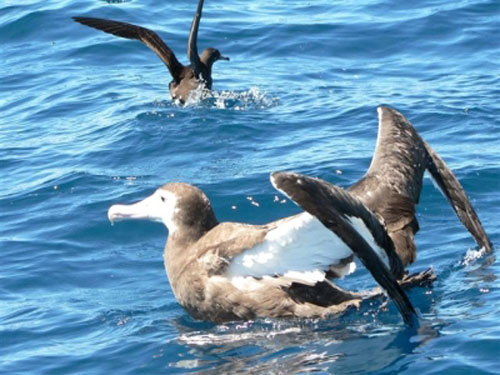Susanne Åkesson (Department of Biology, Lund University, Sweden) and Henri Weimerskirch have looked at the movements of fledging Wandering Albatrosses Diomedea exulans in their first year at sea in the open-access journal PLoS ONE.
The paper’s abstract follows:
“The highly mobile wandering albatrosses (Diomedea exulans) are adapted to navigate the extreme environment of the Southern Ocean and return to isolated islands to breed. Each year they cover several hundreds of thousands of kilometers during travels across the sea. Little is known about the dispersal flights and migration of young albatrosses. We tracked, by satellite telemetry, the departure dispersal of 13 juvenile wandering albatrosses from the Crozet Islands and compared them with tracks of 7 unrelated adults during the interbreeding season. We used the satellite tracks to identify different behavioural steps of the inherited migration program used by juvenile wandering albatrosses during their first solo-migration. Our results show that the juvenile wandering albatrosses from Crozet Islands moved to sex-specific foraging zones of the ocean using at departures selectively the wind. The results suggest that the inherited migration program used by the juvenile wandering albatrosses encode several distinct steps, based on inherited preferred departure routes, differences in migration distance between sexes, and selective use of winds. During long transportation flights the albatrosses were influenced by winds and both adult and juveniles followed approximate loxodrome (rhumbline) routes coinciding with the foraging zone and the specific latitudes of their destination areas. During the long segments of transportation flights across open seas the juveniles selected routes at more northerly latitudes than adults.”

A banded juvenile Wandering Albatross at sea one month off Australia after fledging from Marion Island
Photograph courtesy of Marg Larner
With thanks to Marco Barbieri for information.
Reference:
Åkesson, S. & Weimerskirch, H. 2014. Evidence for sex-segregated ocean distributions of first-winter Wandering Albatrosses at Crozet Islands. PLoS ONE 9. doi:10.1371/journal.pone.0086779.
John Cooper, ACAP Information Officer, 17 April 2014

 English
English  Français
Français  Español
Español